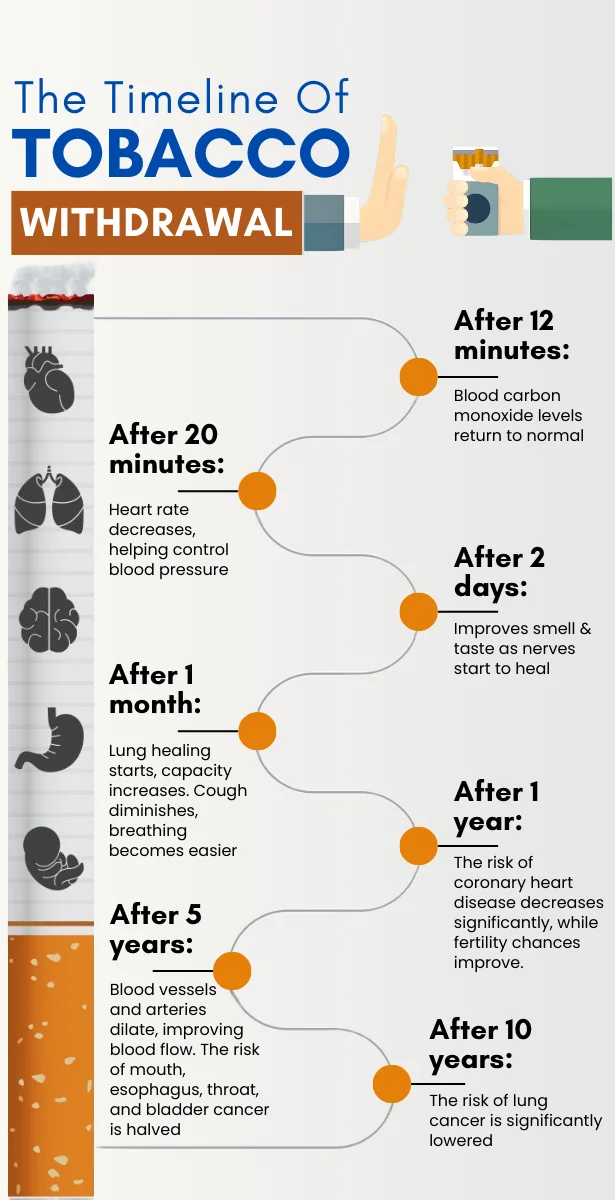How Your Body Repairs Itself After Smoking Cessation
- Updated on: Mar 8, 2025
- 3 min Read
- Published on Mar 8, 2024


Image source: Unsplash
It’s a known fact that smoking can cause many preventable health risks such as cardiovascular diseases, stroke, and lung cancer. However, that’s not where the impacts of smoking end. Smoking can also result in premature skin aging, as the harmful chemicals found in cigarettes can have a negative effect on skin elasticity and health. Additionally, our previous article titled Understanding Gum Disease mentioned how it can lead to gum problems, posing a threat to oral hygiene and health. Overall, smoking affects all aspects of health, and this general smoking-related deterioration is why many people consider quitting to avoid these risks.
While smoking has several effects, there’s still hope for smokers willing to quit. Research has shown that after cessation your body grabs the opportunity to repair itself. The results may not be immediately visible, but you can gradually feel yourself feeling better over time. Here’s a closer look at how the body repairs itself after smoking cessation below:
How the body recovers from smoking
Heart
Smoking leads to systemic inflammation which can elevate the risks of cardiovascular disease. Research published in Springer Nature reveals that by quitting smoking, you lower your blood pressure and reduce systemic inflammation which both contribute to a healthier heart. Upon smoking cessation, your heart rate will drop to a normal level, and after around two weeks, blood can pump through your heart more easily. After a year, the risks of getting a heart attack are significantly reduced because of better blood circulation and heart function.
Skin
Chemicals found in cigarettes can hamper the skin’s production of collagen – a protein responsible for preventing wrinkling and sagging – and also prevent blood from properly circulating, thus causing a lack of nutrient absorption and premature skin aging. When you quit smoking, collagen production in your skin returns to normal. Shallow wrinkles will be able to repair themselves and you’ll notice a healthy glow as your skin is better able to receive necessary nutrients.
Lungs
Cigarette smoking is often associated with lung disease as it damages the lungs’ airways. A study published in BioMed Central shows that those who quit smoking within two years after being diagnosed with chronic obstructive pulmonary disease had lower risks of mortality compared with consistent smokers. Within one to twelve months into your smoking cessation journey, the tiny hair-like structures in your lungs called cilia begin to function properly by removing mucus, thus reducing the risks of infection. The cells in your lungs will also begin to replace the damaged cells in your airways, which leads to the gradual regeneration of the organ tissue.
It’s clear that smoking cessation can help undo some of the damage caused by the harmful chemicals in cigarettes throughout your body. If you’re looking to kick the habit, here are some strategies that can help kickstart your smoking cessation journey:
Strategies for smoking cessation

Cognitive behavioral therapy
Quitting smoking can lead to withdrawal symptoms such as intense cigarette cravings and irritability. Cognitive behavioral therapy allows you to talk to an expert to help you pinpoint smoking triggers and provide healthier coping strategies like yoga and meditation. This allows you to distract yourself from cravings by altering your thoughts and behavior to make healthier choices.
Nicotine pouches
You can try alternatives to cigarettes like nicotine pouches, which are small sacs that you place between your cheek and gum. There are a variety of options currently available on the market with flavors and strengths that can motivate pouch use and eventual cessation. For instance, Juice Head pouches come in fruity flavors that can suit any palate, such as blueberry lemon mint and strawberry mint, with 6mg and 12mg nicotine strengths to help you gradually lower your cigarette cravings. Their pouches also use synthetic nicotine, which means there’s no trace of tobacco, to help facilitate your smoking cessation journey. These pouches require no doctor’s prescription.
Pharmacotherapy
Using prescribed medications is also an effective way to help you quit smoking. Your doctor will most likely recommend options like Chantix varenicline tablets that help alleviate withdrawal symptoms. Given varenicline’s mechanism of action, which simultaneously blocks nicotine receptors while stimulating dopamine release, withdrawal symptoms from smoking are made less impactful. These pills can help take away the enjoyment you get from smoking, boosting your cessation journey significantly. Make sure to check in with your doctor about whether varenicline can be used in conjunction with other cessation options like nicotine patches.
Quitting smoking can greatly benefit your body and health. From reduced risks of heart and lung diseases to youthful skin, smoking cessation helps your body repair damages caused by cigarettes. Be sure to follow these strategies for a better and healthier quality of life.












